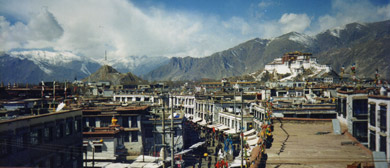A Brief Introduction of Lhasa City (written in 1998)

Setting
Fabric
Modern Times
Official preservation policy
-
National Level |
Regional Level |
The 93 Listed Houses Level
A Brief Introduction of Lhasa City (written in 1998)
Setting |
||
Official Preservation Policy |
| Preservation Activities at National Level | |
|
The state council of the People's Republic of China listed two sites in Lhasa, the Jokhang Temple and the Potala Palace, as nationally protected monuments in 1961. The city of Lhasa has had the official status of being one of China's Historic Cities since the 1980s. Historic City regulations stipulate that construction in the old city area, and especially close to the two national monuments, has to have unspecified "national characteristics", and that new construction may not block the view of the national monuments. The Lhasa City 2000 Development Plan, approved in 1983, mentions that these "national characteristics" should be respected during construction in the old city. In practice, this has often meant little more than giving new facades a Tibetan-style paint-job.
|
| Regional Level Activities | |
|
The Cultural Relics Authority of the Tibet Autonomous Region (TAR), in the late 1980s, declared several sites in the Lhasa valley "regionally protected buildings". Three of these sites are located in the old city: the Tsangkung Nunnery, Muru Sarba Monastery, and the Great Mosque. A further six sites have been listed as protected since 1991 at the Lhasa municipal level. All of these six are religious sites: the Karmashar Temple, the Northern Rigsum Temple, the Southern Rigsum Temple, the Western Rigsum Temple (which is in a new location since 1990- a road runs over the original 7th-century site), the Eastern Rigsum Temple and Murunyingba Monastery. A report on Lhasa compiled in 1991 by China's Central Construction and Planning Authority in Beijing recommended that the old city should be regarded as a special historic area, and that its character be preserved. Nevertheless, the report classifies the vast majority of the old buildings as "dangerous" or "unsafe" housing that need to be replaced. The report only specifically recommends that a further nine sites in Lhasa "have some preservational value". Three of these sites are not monastic in origin: the 18th-century Tromsikhang House, the old Nepali embassy in Lhasa (18th century), and the Nangtseshar Court (founding date presently unknown). The latter, the former Law Court of Lhasa, was restored by the City Cultural Office in 1995 but is not open to the public yet (the municipality plans to eventually use it as a museum). The other seven suggested sites are: the 'little' mosque, the old traditional hospital and medical and astrological college, Mentsikhang; Shide Monastic College (partly in ruins); Tsemoling Monastic College; Tengyeling Temple and the Gyume Lower Tantric College. In February 1995, the municipality officially approved the recommendation to list the sites described as protected buildings, and chose to add the 16th-century Ganden Khangsar complex. [update: Ganden Khangsar was demolished in 2000 and rebuilt as a four-storey housing block.] One of the most important houses on Barkor street, called Labrang Nyingba (bLa-brang rNying-ba) has become a precedent for successful prevention of planned demolition. The site is connected with the 15th century Buddhist reformer, Je Tsongkapa. The Barkor Neighbourhood Committee, an official local administrative unit that used to have its office in the building, announced in 1994 that the old house was going to be demolished and replaced by a new office building. However, the office was visited by many residents who suggested that the house be preserved because of its historical significance. The municipal authorities and the Cultural Office also voiced their concerns. In 1995, the Barkor Neighbourhood Committee announced that the house was definitely not going to be demolished. The Committee instead moved into new premises on the northern strip of the Barkor, built in 1996. Because of the height regulation that came into force, the new office is built in modern Tibetan style and has two storeys only, as did the old Changding House that previously stood on the site. |
| The 93 Listed Houses | |
|
The list was approved by the Lhasa city government in early June 1998, and was read out in full on the Lhasa TV eight o'clock evening news on June 5 1998. Even though some of the 93 protected buildings have been demolished recently [such as Kirey Lobtra, Ganden Khangsar, Samthong], many others are now better looked after than before, and it is believed that the city government will not reverse its decision to keep most of the 93 houses. To sum up, while there has been some action from the government to protect certain religious monuments, and some effort to influence the style of construction in historic areas of Lhasa, previous to the THF cooperation project there has been no official policy to preserve and restore individual historic residential buildings. The June 1998 decision to list 76 buildings marks a genuine shift in official policy towards preservation of the old city.  |
|
| |
|
|
Copyright, Tibet Heritage Fund
|
|